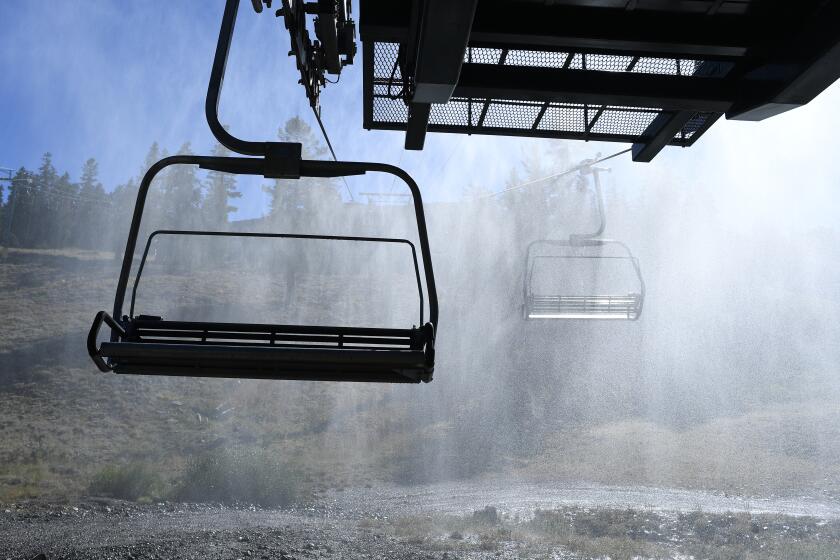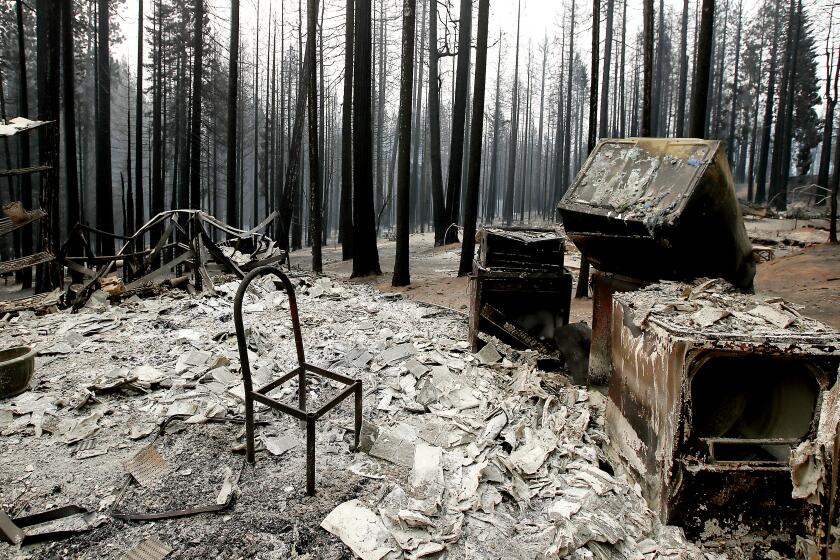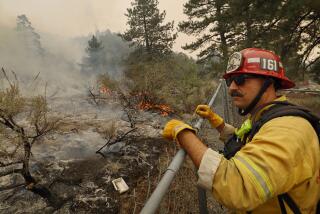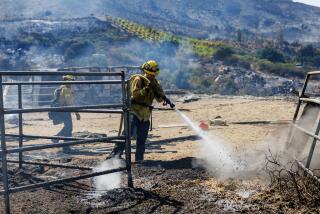Weather helps firefighters make progress against California blazes
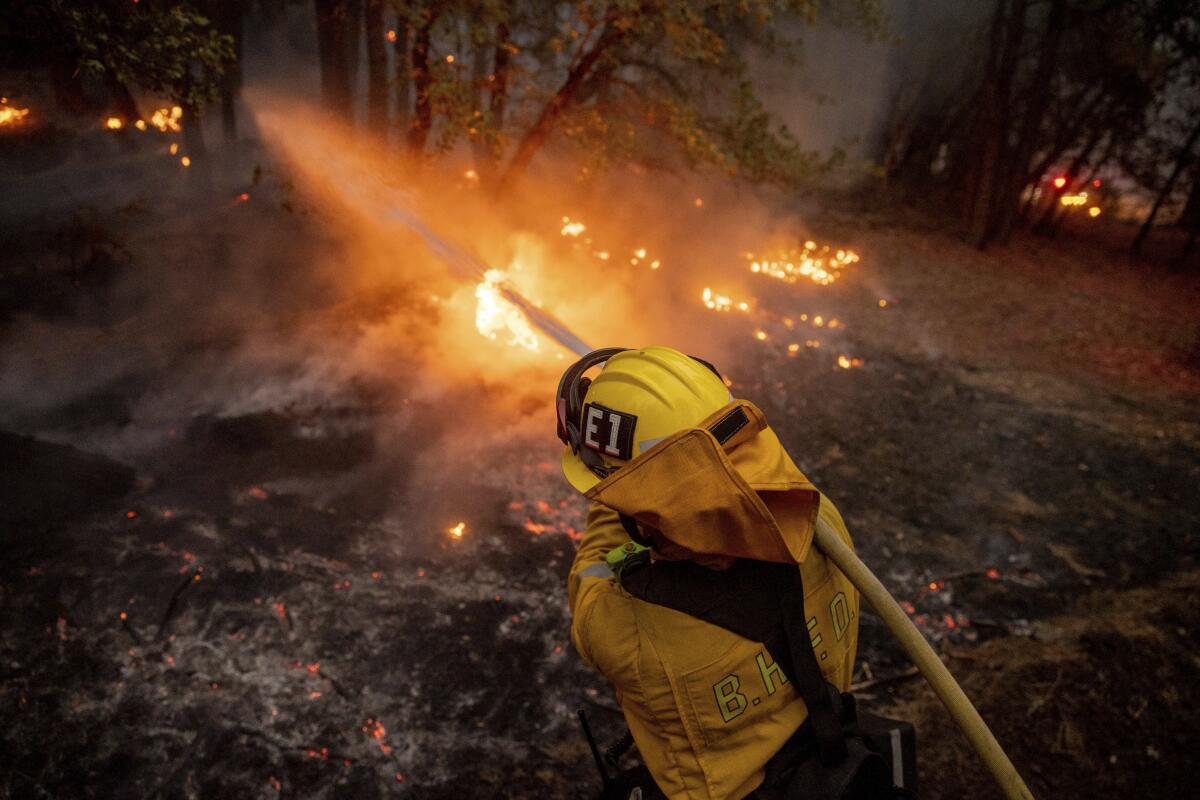
Improved weather conditions helped crews make progress fighting two massive wildfires in Northern California this weekend, but challenges still loomed as they sought to wrestle hundreds of miles of open fire lines under control.
The Dixie fire north of Sacramento had burned 959,253 acres and was 62% contained as of early Saturday, officials said. About 426 people remained evacuated, with those in the Old Station area ordered to flee earlier this week.
Roughly 100 miles to the southeast, the Caldor fire was at 218,489 acres and 60% contained, with about 10,000 people still unable to return to their homes.
The blazes were straining resources amid an intense fire season that experts say has been stoked by the interplay of climate change, drought and a buildup of vegetation in Western U.S. forests.
“This fire season started early,” said Josh Rubinstein, public information officer with the California Department of Forestry and Fire Protection. “And we still have the rest of September and October, and projected into November, yet to come.”
The Dixie fire grew by about 8,000 acres overnight, mostly on the northern end in Lassen Volcanic National Park, according to authorities.
Some rain fell over the southeastern portions of the fire Thursday into Friday, moistening vegetation and decreasing burning intensity, officials said.
“That moisture was very welcome,” said Tim Phelps, public information officer for California Interagency Incident Management Team 1. “Especially the finer fuels like grasses and pine needles on the ground were able to soak that up.” The rain had little effect on larger fuels like stumps, logs and thick layers of decomposing vegetation on the forest floor, he said.
Officials credited aggressive firefighting, improved weather conditions and past efforts to prepare for wildfire with saving the resort town.
But the storm system, which also dropped rain over the Caldor fire, brought lightning as well, with about 755 cloud-to-ground strikes recorded in California and western Nevada between Thursday and Friday, according to the National Weather Service.
The lightning sparked at least eight new starts in the area of the Caldor fire, all of which had been contained by Saturday, said Siobhan Slater, public information officer with the U.S. Forest Service.
Although the rain helped temper the fire’s spread, it had also combined with heavy winds to cause more pine needles and leaves to fall to the ground, which were expected to dry out in the coming days, Slater said.
The Caldor fire was most active north of Strawberry Creek, where hotshot and bulldozer crews were working with air operations to complete line construction, she said.
Some 3,989 personnel were assigned to the fire, which had destroyed 782 homes and 18 commercial properties since it started south of Grizzly Flats on Aug. 14. No structures have burned for several days, Slater said Saturday. The fire’s cause remained under investigation.
Winds had died down in the area of the Dixie fire, with gusts of 20 mph compared with 40- to 45-mph gusts that had carried embers up to six miles ahead of the fire over the past couple days, said Rubinstein. The reprieve allowed firefighters to attack the flames more aggressively, he said.
“We can put firefighters on the fire’s edge and use dozers,” he said, adding that they are working together with fixed-wing aircraft and helicopters.
Crews in the eastern zone of the fire were working to widen control lines, some of which were already as deep as 200 feet, Phelps said.
“As they get deeper and deeper, we turn them into a containment line,” he said, meaning that officials are confident flames will not cross the line.
A key goal was to take advantage of the weather over the next couple days to repopulate areas that had been evacuated, Rubinstein said.
Still, the effects of the rain weren’t expected to last long, with temperatures projected to steadily rise over the weekend and dry things out in the areas of both fires.
A high-pressure system was expected to push temperatures into the 70s at higher elevations and the mid-80s in lower elevations, as much as five degrees above normal in some places, said Hannah Chandler-Cooley, meteorologist with the National Weather Service in Sacramento.
“We still have 38% of this fire that is uncontained, which is somewhere in the neighborhood of 300 miles of open fire line,” Rubinstein said of the Dixie fire. “That doesn’t mean it’s a flaming front, but there is a lot of work still to be done.”
The lines around the southern edge of the fire, near Quincy and Portola over to Milford, were looking good, with crews working to reinforce them and mop up, Phelps said.
They were also dealing with a couple hotspots: one in the Dixie Mountain area, where there are some structures, and a second in the Devil’s Punchbowl area, where the fire was burning in remote, rugged terrain but could push up toward toward Taylorsville or down toward Quincy, Phelps said.
“Spots have been hot in there for two weeks now, so crews are in there working to go direct and build some line right up against the fire’s edge where they can,” he said. There are contingency lines in place to protect the towns, should the fire make a run, he added.
The Dixie fire started near a Pacific Gas and Electric Co. power station in Feather River Canyon on July 13 and might have been sparked by a tree falling into a power line, the utility has said. Nine days later, PG&E equipment may have ignited the Fly fire nearly 30 miles to the northeast, which eventually merged with Dixie.
The fire has destroyed 736 homes, 139 commercial buildings and eight mixed-use properties while growing into the second-largest in California history. As of Saturday morning, the fire was about 74,000 acres shy of the largest, last year’s August Complex fire.
The challenges of coordinating such a massive incident are immense, authorities said.
The population of the Dixie fire’s base camps are larger than some towns, with about 4,878 personnel assigned to the incident. Crews are monitoring and patrolling hundreds of miles of perimeter and extinguishing hotspots that creep over. As containment grows, resources can be shifted to attack hotter areas more aggressively, Phelps said.
For many residents in Northern California, summer has now become a time of dread due to extreme wildfires.
The fire has burned about 1,400 square miles, Rubinstein noted.
“That’s bigger than any of us can imagine,” said Scott Stephens, professor of fire science at UC Berkeley. “That is so big, it’s a mind-blowing experience.”
By comparison, he said he was stunned when the Moonlight fire in 2007 in eastern Plumas County reached 80,000 acres.
“We thought that was just unbelievable,” he said.
Stephens attributes the increase in large, high-intensity fires to decades of aggressive fire suppression in many forested areas, resulting in an increase in the density of trees and downed vegetation.
Data shows that in 1910 and 1911, there were about 40 to 60 trees per acre in the mixed-conifer forests of the Southern Cascades and the Sierra Nevada, and they were dominated by pine species and larger trees, which are more resistant to drought, disease and fire, Stephens said.
“If you look today, there are 200 or 300 trees per acre or more,” he said, with more invasive species and smaller trees that tend to burn more quickly and die more easily from drought stress and pests.
The amount of woody debris on the ground, which can help fire spread more quickly and burn more intensely by carrying it up into the tree canopy, has also increased, from about 10 tons an acre to roughly 30 tons an acre, he said.
The changes have left these forests more vulnerable to the effects of drought and climate change, which have caused yet more trees to die and dry out, becoming combustible, he said.
“And eventually, it all comes together and you get a fire that nears a million acres,” he said.
More to Read
Sign up for Essential California
The most important California stories and recommendations in your inbox every morning.
You may occasionally receive promotional content from the Los Angeles Times.
